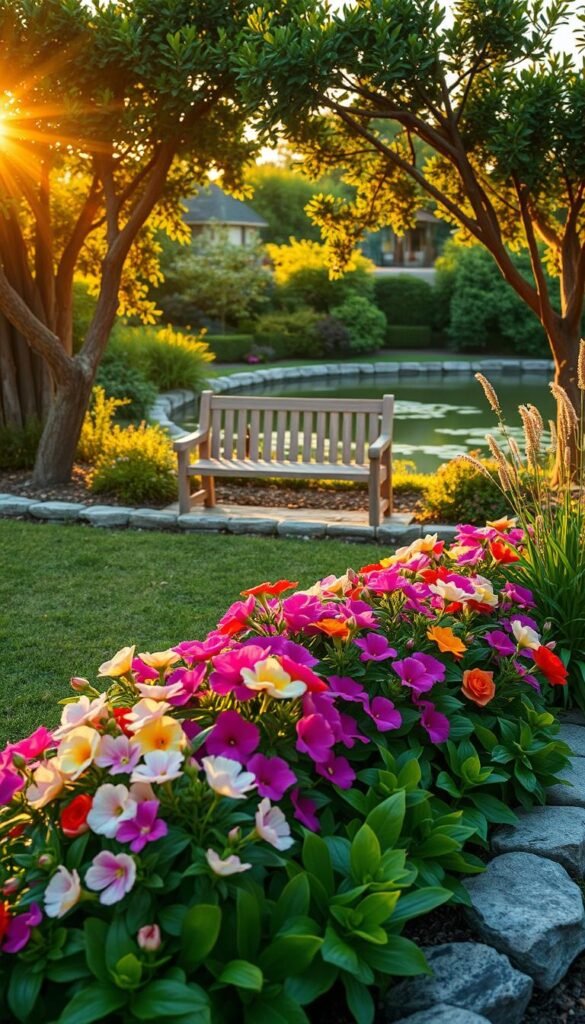Dreaming of a beautiful yard but worried about costs? You’re not alone. Many homeowners assume stunning landscapes require endless spending, but smart planning and creativity can turn even modest budgets into eye-catching results. Whether you’re starting fresh or refreshing an existing area, this guide will help you maximize every dollar.
Before picking up a shovel, take time to understand your unique space. Sunlight patterns, soil quality, and local climate all play vital roles in long-term success. Simple steps like improving dirt health or choosing native plants save money and reduce maintenance headaches later.
We’ll walk through practical strategies that balance beauty and practicality. Learn how to prioritize projects, repurpose materials, and select plants that thrive in your region. From cozy cottage vibes to sleek modern layouts, discover styles that match your taste without straining your wallet.
Ready to create an outdoor retreat you’ll love? Let’s explore how thoughtful preparation and clever budget-friendly ideas can make your vision a reality—no financial stress required.
Garden Design Inspiration: Setting the Scene
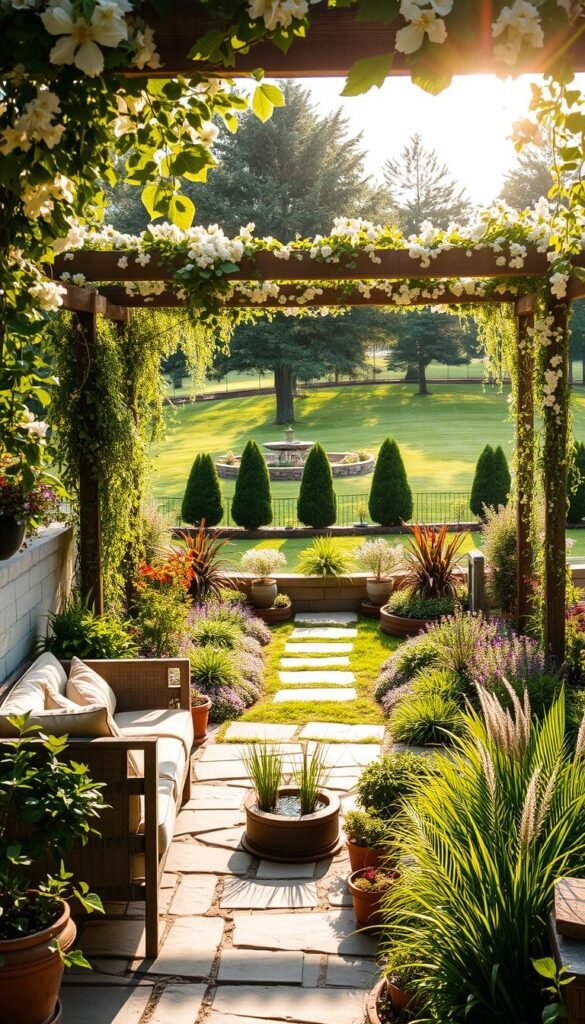
Creating an inviting outdoor retreat starts with smart observation. Before diving into plant choices or decor, take a walk around your yard. Notice where sunlight lingers longest, which areas stay damp, and what existing features could shine with minor updates.
Understanding Your Garden Space
Measure your plot using free apps or graph paper. Sketch slopes, trees, and structures that impact your layout. Healthy soil matters most—test its pH and texture. Sandy dirt? Add compost. Clay-heavy? Mix in perlite for drainage.
Budget Considerations for Every Plan
Transformations don’t require big spending. Start with focal points like elevating your porch borders using thrifted containers. Seasonal sales at nurseries offer 30-50% off perennials in late summer. Buy seeds instead of mature plants for annual blooms.
| Project Type | Average Cost | Savings Tip |
|---|---|---|
| Container Garden | $50-$200 | Repurpose old buckets |
| Raised Beds | $150-$500 | Use untreated pallets |
| Full Landscape | $2,000+ | Phase projects over 2 years |
Prioritize plants offering multiple benefits. Lavender deters pests and adds fragrance. Native shrubs reduce watering needs while supporting local birds. Track prices—mulch costs drop in fall, tools go on clearance post-summer.
Essential Garden Design Plans for Every Budget
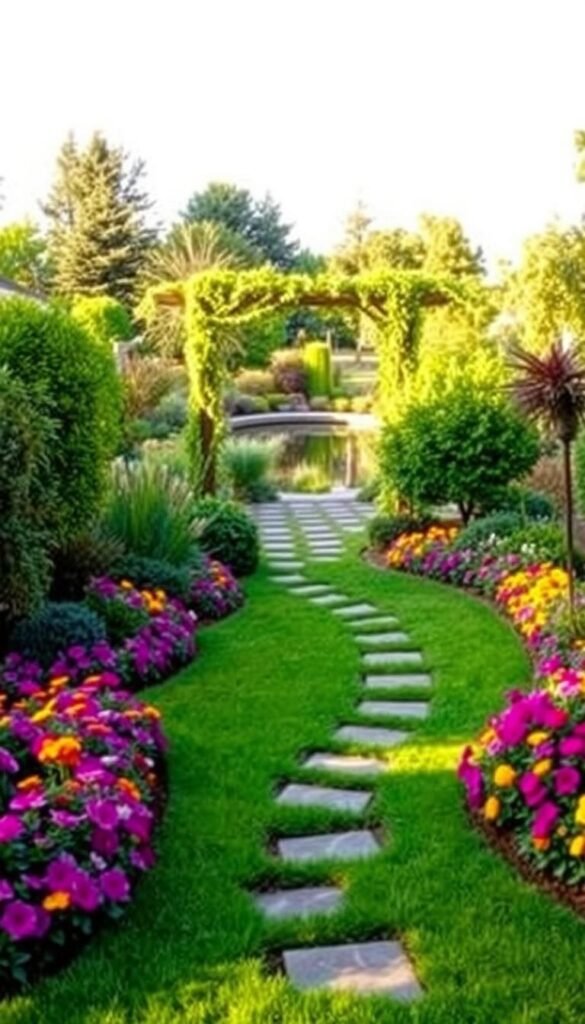
Great outdoor spaces begin with smart arrangements that work today and tomorrow. Start by playing with color contrasts—pair purple salvia with yellow marigolds for instant drama. Tall grasses behind low-growing flowers create depth, while repeating shapes like circular stone paths tie areas together.
Beginner-friendly patterns make upkeep simple. Try symmetrical beds flanking a walkway or clustered pots in odd numbers (3, 5, 7). For natural charm, curve planting zones around existing trees. One homeowner transformed their sloped yard using terraced raised beds built from reclaimed wood, proving creativity beats big budgets.
“A well-planned space feels complete even when half-finished.”
Keep seasons in mind. Evergreen shrubs anchor winter views, while spring bulbs and fall-blooming asters ensure constant color. Mix textures—feathery ferns beside spiky yucca—for year-round intrigue. Start small: define one focal area this month, then expand next year as time and funds allow.
Adaptable templates help you pivot. Love cottage vibes but need low-water options? Swap roses for drought-tolerant lavender. Prefer modern lines? Edge geometric beds with ornamental cabbage. Your space should reflect your life’s rhythm, not drain your wallet.
Outdoor Space Makeovers: Modern DIY Ideas
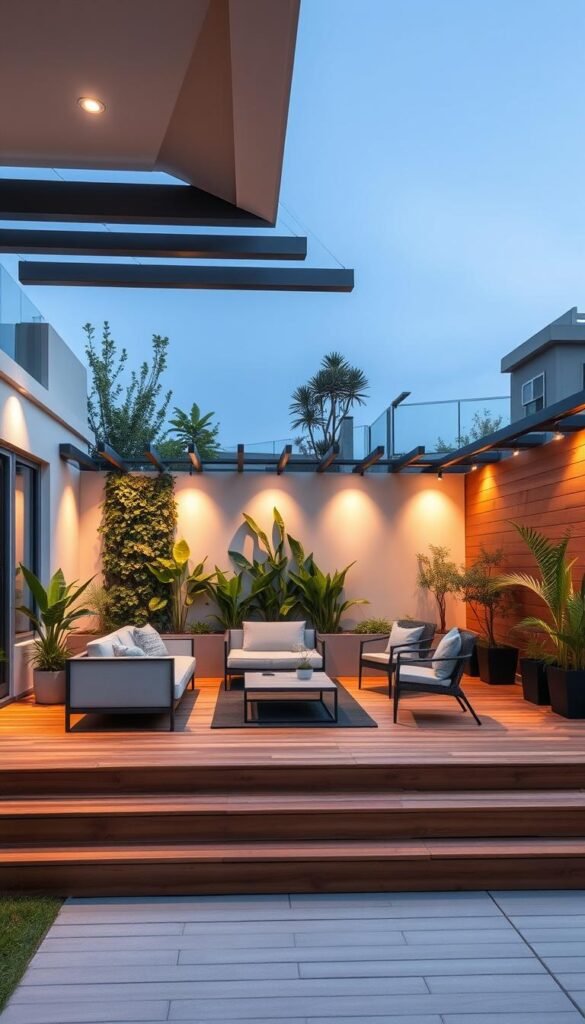
Breathing new life into your yard doesn’t require a contractor or hefty budget. With clever DIY ideas, you can turn overlooked corners into eye-catching features. Start by building an arched trellis from PVC pipes or reclaimed wood—perfect for climbing roses or beans. It adds vertical interest while doubling as a privacy screen.
Raised beds offer an easy way to improve drainage and organize plants. Use untreated cedar planks or stacked stones for a polished look. Pair them with tiered terra-cotta pots filled with herbs—this saves ground space while creating vibrant layers.
| Project | Materials | Time |
|---|---|---|
| Arched Trellis | PVC pipes, zip ties | 2 hours |
| Gutter Planters | Vinyl gutters, brackets | 45 minutes |
| Sun Catchers | Wooden cutouts, acrylic paint | 1 hour |
Repurpose everyday items for unexpected flair. Old vinyl gutters become hanging herb gardens on porches—drill drainage holes and secure with sturdy hooks. For playful decor, craft sun catchers using painted wooden shapes and beads. They catch light beautifully and add whimsy to shaded spots.
“The best outdoor spaces whisper creativity, not expense.”
Short on room? Try vertical displays. Group terra-cotta pots on a ladder-style shelf, or mount wall planters using pallet wood. These DIY patio ideas prove even compact areas can burst with personality. Start small, experiment often, and let your space evolve organically.
Designing with Nature: Woodland Paths and Wildflower Ideas
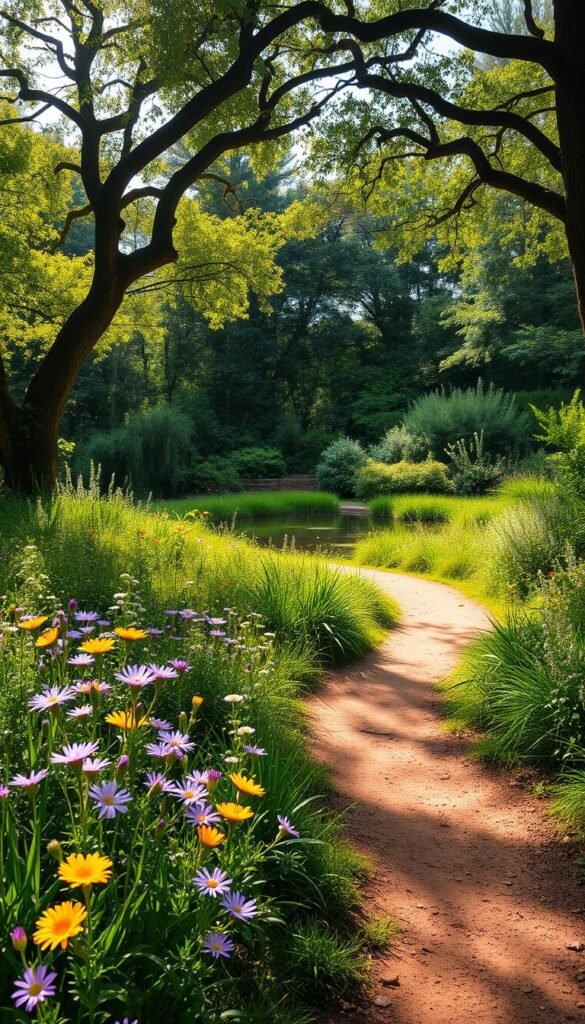
Transform your backyard into a natural sanctuary with winding paths and vibrant wildflowers. These styles blend seamlessly with existing landscapes while fostering deeper connections to local ecosystems. Let’s uncover how to weave these organic elements into your space.
Exploring the Woodland Path Garden Plan
Curving trails lined with ferns and moss create immersive journeys through your yard. Use mulch or irregular stepping stones to mimic forest floors. Edge paths with shade-loving plants like hostas or bleeding hearts for texture. This approach lets you witness spring ephemerals up close as seasons shift.
Benefits of a Wildflower Garden
Native blooms like coneflowers and black-eyed Susans thrive with minimal care once established. They attract butterflies and hummingbirds while improving soil health. Unlike high-maintenance lawns, wildflower patches need mowing just once yearly—after seeds drop.
Choose regional species for better drought resistance and pest tolerance. Many nurseries offer pre-mixed seed packets tailored to your area. Over time, these flowers self-sow, creating ever-changing displays that surprise you yearly. It’s a sustainable way to support pollinators without constant effort.
Year-Round Appeal: Bark, Deer-Resistant, and Pollinator Gardens
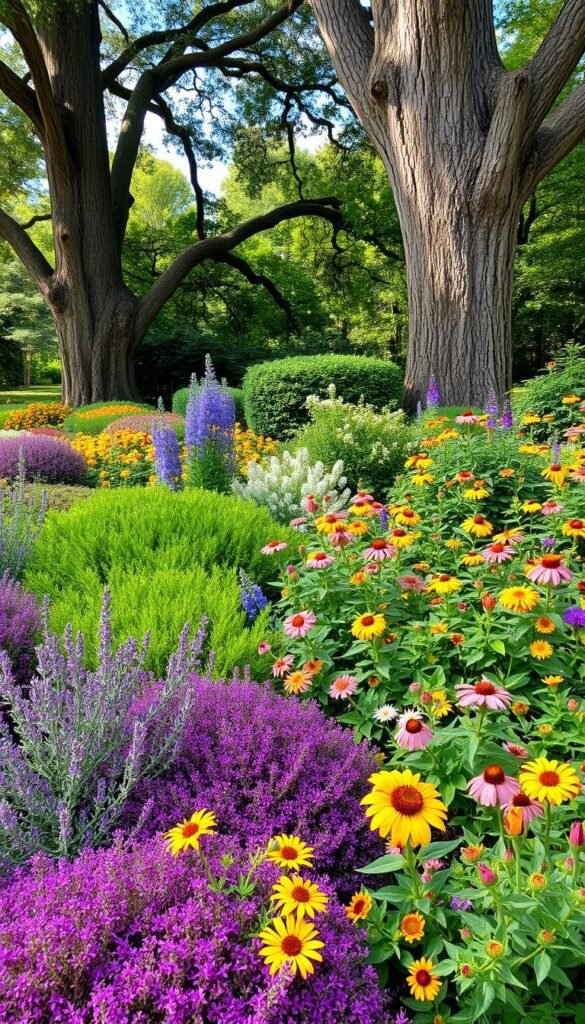
Your outdoor space can captivate in every season with smart plant choices. Let’s explore three approaches that balance beauty, practicality, and ecological harmony.
Bark-Appeal Garden Insights for Winter Interest
Winter landscapes needn’t feel barren. Trees like paper birch and shrubs like red twig dogwood shine when other plants sleep. Their peeling bark or crimson stems create striking contrasts against snow. For texture, try coral bark maple or lacebark pine—their unique surfaces catch frost beautifully.
Creating a Deer-Resistant Landscape
Swap deer favorites like hostas for aromatic alternatives. Lavender, Russian sage, and boxwood shrubs naturally deter grazing. Pair them with spiky yucca or fuzzy lamb’s ear for added protection through texture diversity.
| Deer-Resistant Plant | Key Feature | Maintenance Level |
|---|---|---|
| Butterfly Bush | Fragrant blooms | Low |
| Barberry | Thorny stems | Moderate |
| Foxglove | Toxic leaves | Low |
Attracting Local Pollinators to Your Garden
Native flowers like purple coneflower and milkweed sustain bees and butterflies from spring through fall. Cluster plants in groups of five for better visibility. Include late bloomers like asters to support migrating monarchs. For winter-active species, add cold-hardy plants like witch hazel.
These strategies prove that thoughtful planting creates living art while supporting local ecosystems. Your space becomes a sanctuary that evolves beautifully through the year.
Practical Garden Spaces: Kitchen, Herb, and Cottage Garden Inspirations
Transform your outdoor area into a productive paradise that feeds both body and soul. Blending edibles with aesthetics lets you harvest fresh ingredients while crafting inviting spaces. Let’s explore layouts that turn practicality into artistry.
Discover the Ultimate Kitchen Garden Plan
A well-organized potager mixes vegetables, flowers, and herbs for visual harmony. Start with raised beds or geometric plots using materials like brick or salvaged timber. Pair leafy kale with marigolds to deter pests naturally, or train beans up decorative obelisks for vertical flair.
- Rotate crops annually to maintain soil health
- Include pollinator-friendly blooms like zinnias
- Use trellises to maximize small footprints
Starting Your Very Own Herb Garden
Fresh flavors thrive right outside your kitchen door. Basil, thyme, and mint flourish in sunny spots—even in window boxes. Perennial rosemary and sage offer year-round greenery, while annual cilantro gives quick bursts of flavor.
“Herbs thrive on neglect—overwatering kills more plants than drought.”
For limited spaces, try tiered planters or hanging baskets. Mix textures: feathery dill beside velvety sage creates sensory appeal. Dry extras for winter use or share cuttings with neighbors—herbs grow quickly and generously.
Maximizing Impact in Small Areas: Porch Borders, Raised Beds, and Patio Garden Beds
Small spaces hold big potential when approached thoughtfully. Whether you’re working with a postage-stamp porch or a narrow patio, strategic layouts turn limitations into advantages. Focus on vertical layers, multi-purpose features, and plants that punch above their weight class.
Elevate Your Porch Garden with Creative Ideas
Turn entryways into green showcases using vertical planters and thrifted containers. Hang ferns in macramé holders above dwarf citrus trees in colorful pots. Mix edible herbs like basil with trailing nasturtiums for a feast of textures. Pro tip: Match container colors to your home’s trim for instant cohesion.
For shady spots, pair coleus with impatiens—their vibrant leaves thrive without direct sun. Sunny porches? Try compact cherry tomatoes beside drought-tolerant sedum. Always leave walking space, and use low benches with built-in storage for tools or seasonal decor.
The Advantages of Raised Bed Gardening
Raised garden beds solve multiple challenges at once. They prevent soil compaction, deter pests, and let you customize growing conditions. Build them alongside patios to blur indoor-outdoor lines, or tuck a trio into unused side yards. Follow this step-by-step raised bed guide for a weekend project that lasts years.
Opt for cedar or stone materials that complement your home’s style. Fill beds with native perennials for low upkeep, or rotate seasonal veggies for fresh harvests. Their elevated height reduces back strain—no more kneeling in dirt. Plus, you’ll spend less time weeding and more time enjoying your patio oasis.
Transformative Water Features and Vertical Garden Ideas
Water and vertical elements bring dynamic energy to even the smallest yards. Imagine trickling fountains softening urban noise while climbing vines create living curtains of color. These features work together to turn cramped areas into multi-sensory retreats—no sprawling space required.
Tips for a Compact Water Garden
Small water features fit perfectly on patios or balconies. Convert whiskey barrels into self-contained ecosystems—add a solar pump for gentle circulation. For tighter budgets, use ceramic bowls with floating plants like water lettuce. Position them near seating areas to enjoy their calming sounds daily.
| Feature Type | Cost Range | Maintenance |
|---|---|---|
| Barrel Pond | $80-$150 | Weekly debris removal |
| Tabletop Fountain | $40-$90 | Monthly pump check |
| Bubbling Urn | $120-$300 | Seasonal draining |
Innovative Vertical Planting Solutions
When ground space vanishes, grow upward. Attach pocket planters to walls for strawberries or trailing petunias. Train clematis or morning glories on trellises—they’ll cover fences in weeks. Even shady spots thrive with ferns in stacked wooden crates.
Choose fast-growing plants for quick impact:
- Sweet peas: Fragrant blooms from spring to fall
- Ivy: Evergreen coverage for privacy screens
- Nasturtiums: Edible flowers that cascade beautifully
These vertical solutions prove that empty surfaces hold untapped potential. Pair them with your water feature to create a layered oasis that feels larger than its footprint.
Budget-Friendly DIY Projects and Garden Accessories
Who says stylish outdoor spaces need expensive store-bought decor? With simple materials and imagination, you can craft unique accents that breathe life into your yard. Let’s explore creative ways to blend functionality with personality—without draining your wallet.
Crafting a Cheerful Sun Catcher
Brighten shady corners with handmade sun catchers. Start with wooden flower shapes from craft stores—sunflowers work beautifully. Paint them vibrant yellows and oranges using weather-resistant acrylics. Thread beads onto fishing line, alternating glass and metallic pieces to catch light. Hang your creation where afternoon rays filter through for dazzling displays.
Repurposing Materials for Garden Accessories
Turn forgotten items into functional art. Old tires become raised beds when stacked and filled with soil—paint them cobalt blue for extra flair. Chipped teacups? Drill drainage holes and plant succulents. Even cracked pots get new life as fairy garden homes when tilted sideways.
| Material | New Use | Cost Savings |
|---|---|---|
| Tires | Raised beds | 90% vs. store-bought |
| Bricks | Path edging | 100% (salvaged) |
| Cans | Herb planters | 80% vs. ceramic pots |
Check your shed before shopping. Ladder missing rungs? Lean it against a wall for vertical plant displays. Broken chair? Remove the seat and add a mosaic-tiled tray as a side table. These projects prove beauty thrives where creativity meets resourcefulness.
Expert Tips for Selecting Perfect Plants and Flowers
Choosing the right greenery shouldn’t feel like solving a puzzle. Start by assessing your space’s sunlight patterns and soil type. Plants labeled as “full sun” need 6+ hours of direct light—great for south-facing areas. Shade lovers like hostas thrive under trees or north-side beds.
Check mature sizes before buying. That cute 12-inch shrub could become a 6-foot beast in three years. Look for compact varieties if space is tight. Pro tip: Nurseries often group flowers by water needs—cluster drought-tolerant picks together for easier care.
“A plant’s tag tells its life story—read it like a roadmap to success.”
Time purchases with your season’s planting window. Cool-weather crops like pansies establish best in fall, while tomatoes crave warm soil. Many stores discount perennials in late summer—perfect for budget-friendly expansions.
| Plant Type | Ideal Conditions | Maintenance Level |
|---|---|---|
| Native Perennials | Local climate | Low |
| Annual Blooms | Rich soil | Moderate |
| Evergreen Shrubs | Well-drained areas | Low |
Mix textures and heights for visual impact. Pair spiky lavender with mounding begonias, or let climbing clematis frame taller plants. Smart choices today mean fewer replacements tomorrow—your wallet will thank you.
Seasonal Garden Strategies for Every Climate
Adapting your green space to seasonal shifts keeps it vibrant year-round. Start by mapping your local frost dates and soil needs—tools like a beginner’s gardening checklist simplify this process. Pair early spring bulbs with late-blooming perennials for nonstop color.
Planting for Summer and Spring Success
Cool-weather crops like kale thrive when planted 4-6 weeks before last frost. Once temperatures rise, transition to heat-loving tomatoes and peppers. Use succession planting—swap spent lettuce for bush beans—to maximize small plots all summer.
Finding Winter Blooming Favorites
Hellebores defy chilly weather with rose-like flowers from December to March. Underplant them with snowdrops for early texture. Protect spring bulbs from critters by choosing daffodils over tulips—their bitter taste deters digging pests.
Remember: every season offers unique opportunities. Test soil annually to adjust nutrients, and let regional climate guide your plant picks. With smart timing, your space becomes a living calendar that celebrates nature’s cycles.

